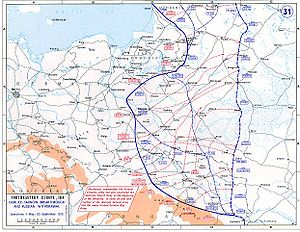| Gorlice breakthrough | |||||||
|---|---|---|---|---|---|---|---|
| Part of Gorlice-Tarnów Offensive in the Eastern Front during World War I | |||||||
 Gorlice-Tarnów breakthrough and Russian withdrawal | |||||||
| |||||||
| Belligerents | |||||||
|
|
| ||||||
| Commanders and leaders | |||||||
|
|
| ||||||
| Units involved | |||||||
|
|
| ||||||
| Strength | |||||||
|
On May 1:[1] 401,041 men 525 machine guns 729 guns |
On May 1:[2] 700,299 men 734 machine guns 1,691 guns | ||||||
| Casualties and losses | |||||||
|
100,000 prisoners 80 guns and 250 machine guns captured Unknown but very large number of KIA and WIA[3] | 36,570[4][5]–90,000[6] | ||||||
The Gorlice breakthrough occurred in the May 1–10, 1915 as part of the Gorlice–Tarnów Offensive during World War I. The German 11th Army led by General August von Mackensen, with the support on the flanks by the 3rd and 4th Austro-Hungarian Armies, defeated the 3rd Russian Army. For the first time in the history of the First World War a heavily fortified and long-term defensive position was broken through during the Gorliсе offensive.
- ^ С.Г. Нелипович, 2022, p. 289
- ^ С.Г. Нелипович, Русский фронт Первой мировой войны. Потери сторон 1915, 2022, p. 289 calculated according to: Oesterreich-Ungarns letzter Krieg 1914–1918. Bd. 2. Beilage 14: Oesta-KA. AOK – Quartiermeister-Abteilung. Karton 1522. Op. 50500 (1915): Karton 2694. Op. 102017 (1915): Karton 2699. Op. 23900 (1915)
- ^ С.Г. Нелипович, 2022, p. 307
- ^ Rotkirch, Graf von, Trach. Freiherr von, L. Gorlice-Tarnow. pp. 78–79: Sanitaetsbericht ueber das Deutsche Heer (Deutsche Feld – und Besatzungsheer) im Weltkriege 1914/18. Berlin. 1936. Bd. II. p. 43
- ^ С.Г. Нелипович, 2022, p. 307
- ^ Bichanina 2018, p. 78.